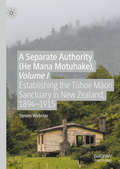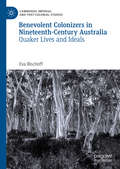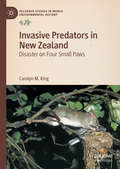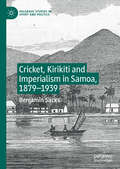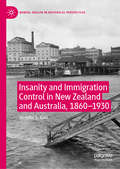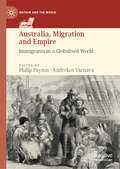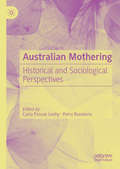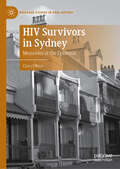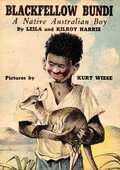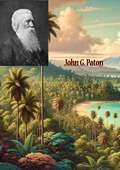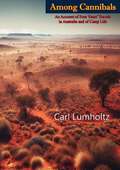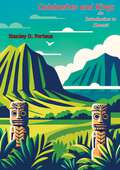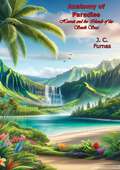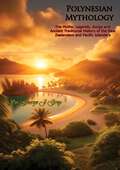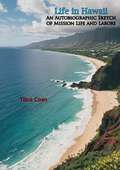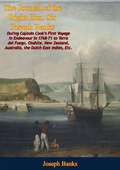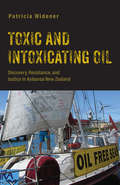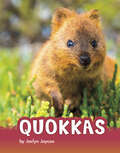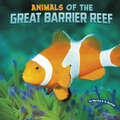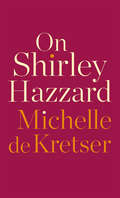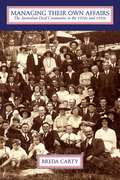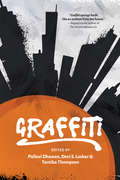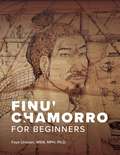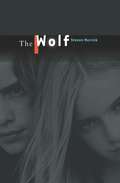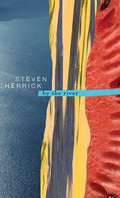- Table View
- List View
A Separate Authority (He Mana Motuhake), Volume I: Establishing the Tūhoe Māori Sanctuary in New Zealand, 1894–1915
by Steven WebsterThis book is an ethnohistorical reconstruction of the establishment in New Zealand of a rare case of Maori home-rule over their traditional domain, backed by a special statute and investigated by a Crown commission the majority of whom were Tūhoe leaders. However, by 1913 Tūhoe home-rule over this vast domain was being subverted by the Crown, which by 1926 had obtained three-quarters of their reserve. By the 1950s this vast area had become the rugged Urewera National Park, isolating over 200 small blocks retained by stubborn Tūhoe "non-sellers". After a century of resistance, in 2014 the Tūhoe finally regained statutory control over their ancestral domain and a detailed apology from the Crown.
Benevolent Colonizers in Nineteenth-Century Australia: Quaker Lives and Ideals (Cambridge Imperial and Post-Colonial Studies Series)
by Eva BischoffThis book reconstructs the history of a group of British Quaker families and their involvement in the process of settler colonialism in early nineteenth-century Australia. Their everyday actions contributed to the multiplicity of practices that displaced and annihilated Aboriginal communities. Simultaneously, early nineteenth-century Friends were members of a translocal, transatlantic community characterized by pacifism and an involvement in transnational humanitarian efforts, such as the abolitionist and the prison reform movements as well as the Aborigines Protection Society. Considering these ideals, how did Quakers negotiate the violence of the frontier? To answer this question, the book looks at Tasmanian and South Australian Quakers’ lives and experiences, their journeys and their writings. Building on recent scholarship on the entanglement between the local and the global, each chapter adopts a different historical perspective in terms of breadth and focused time period. The study combines these different takes to capture the complexities of this topic and era.
Invasive Predators in New Zealand: Disaster on Four Small Paws (Palgrave Studies in World Environmental History)
by Carolyn M. KingThe story of invasive species in New Zealand is unlike any other in the world. By the mid-thirteenth century, the main islands of the country were the last large landmasses on Earth to remain uninhabited by humans, or any other land mammals. New Zealand’s endemic fauna evolved in isolation until first Polynesians, and then Europeans, arrived with a host of companion animals such as rats and cats in tow. Well-equipped with teeth and claws, these small furry mammals, along with the later arrival of stoats and ferrets, have devastated the fragile populations of unique birds, lizards and insects. Carolyn M. King brings together the necessary historical analysis and recent ecological research to understand this long, slow tragedy. As a comprehensive historical perspective on the fate of an iconic endemic fauna, this book offers much-needed insight into one of New Zealand’s longest-running national crises.
Cricket, Kirikiti and Imperialism in Samoa, 1879–1939 (Palgrave Studies in Sport and Politics)
by Benjamin SacksThis book considers how Samoans embraced and reshaped the English game of cricket, recasting it as a distinctively Samoan pastime, kirikiti. Starting with cricket’s introduction to the islands in 1879, it uses both cricket and kirikiti to trace six decades of contest between and within the categories of ‘colonisers’ and ‘colonised.’ How and why did Samoans adapt and appropriate the imperial game? How did officials, missionaries, colonists, soldiers and those with mixed foreign and Samoan heritage understand and respond to the real and symbolic challenges kirikiti presented? And how did Samoans use both games to navigate foreign colonialism(s)? By investigating these questions, Benjamin Sacks suggests alternative frameworks for conceptualising sporting transfer and adoption, and advances understandings of how power, politics and identity were manifested through sport, in Samoa and across the globe.
Insanity and Immigration Control in New Zealand and Australia, 1860–1930 (Mental Health in Historical Perspective)
by Jennifer S. KainThis book examines the policy and practice of the insanity clauses within the immigration controls of New Zealand and the Commonwealth of Australia. It reveals those charged with operating the legislation to be non-psychiatric gatekeepers who struggled to match its intent. Regardless of the evolution in language and the location at which a migrant’s mental suitability was assessed, those with ‘inherent mental defects’ and ‘transient insanity’ gained access to these regions. This book accounts for the increased attempts to medicalise border control in response to the widening scope of terminology used for mental illnesses, disabilities and dysfunctions. Such attempts co-existed with the promotion of these regions as ‘invalids’ paradises’ by governments, shipping companies, and non-asylum doctors. Using a bureaucratic lens, this book exposes these paradoxes, and the failings within these nineteenth- and early twentieth-century Australasian nation-state building exercises.
Australia, Migration and Empire: Immigrants in a Globalised World (Britain and the World)
by Andrekos Varnava Philip PaytonThis edited collection explores how migrants played a major role in the creation and settlement of the British Empire, by focusing on a series of Australian case studies. Despite their shared experiences of migration and settlement, migrants nonetheless often exhibited distinctive cultural identities, which could be deployed for advantage. Migration established global mobility as a defining feature of the Empire. Ethnicity, class and gender were often powerful determinants of migrant attitudes and behaviour. This volume addresses these considerations, illuminating the complexity and diversity of the British Empire’s global immigration story. Since 1788, the propensity of the populations of Britain and Ireland to immigrate to Australia varied widely, but what this volume highlights is their remarkable diversity in character and impact. The book also presents the opportunities that existed for other immigrant groups to demonstrate their loyalty as members of the (white) Australian community, along with notable exceptions which demonstrated the limits of this inclusivity.
Australian Mothering: Historical and Sociological Perspectives
by Petra Bueskens Carla Pascoe LeahyThis collection defines the field of maternal studies in Australia for the first time. Leading motherhood researchers explore how mothering has evolved across Australian history as well as the joys and challenges of being a mother today. The contributors cover pregnancy, birth, relationships, childcare, domestic violence, time use, work, welfare, policy and psychology, from a diverse range of maternal perspectives. Utilising a matricentric feminist framework, Australian Mothering foregrounds the experiences, emotions and perspectives of mothers to better understand how Australian motherhood has developed historically and contemporaneously. Drawing upon their combined sociological and historical expertise, Bueskens and Pascoe Leahy have carefully curated a collection that presents compelling research on past and present perspectives on maternity in Australia, which will be relevant to researchers, advocates and policy makers interested in the changing role of mothers in Australian society.
HIV Survivors in Sydney: Memories of the Epidemic (Palgrave Studies in Oral History)
by Cheryl WareInner-city Sydney was the epicenter of gay life in the Southern hemisphere in the 1970s and early 1980s. Gay men moved from across Australasia to find liberation in the city’s vibrant community networks; and when HIV and AIDS devastated those networks, they grieved, suffered, and survived in ways that have often been left out of the historical record. This book excavates the intimate lives and memories of HIV-positive gay men in Sydney, focusing on the critical years between 1982 and 1996, when HIV went from being a terrifying unidentified disease to a chronic condition that could be managed with antiretroviral medication. Using oral histories and archival research, Cheryl Ware offers a sensitive, moving exploration of how HIV-positive gay men navigated issues around disclosure, health, sex, grief, death, and survival. HIV Survivors in Sydney reveals how gay men dealt with the virus both within and outside of support networks, and how they remember these experiences nearly three decades later.
Blackfellow Bundi: A Native Australian Boy
by Leila Gott Harris Kilroy HarrisLeila Gott Harris’s Blackfellow Bundi: A Native Australian Boy offers a tender and insightful portrayal of the life and experiences of Bundi, a young Aboriginal boy navigating the challenges and joys of his cultural heritage in the Australian bush. Written with empathy and vivid detail, the book brings to life the traditions, struggles, and resilience of Indigenous Australians in a rapidly changing world.Through Bundi’s eyes, readers are introduced to the beauty of the land, the deep connection of his people to their environment, and the wisdom passed down through generations. Harris explores themes of identity, community, and belonging, as Bundi learns about his culture and navigates the complexities of interactions with settlers and the encroaching modern world.Rich with evocative descriptions and heartfelt moments, Blackfellow Bundi captures the spirit of a boy growing up in a time of cultural collision, where the preservation of heritage stands alongside the pressures of change. Harris weaves a narrative that is both educational and moving, offering readers a glimpse into the unique perspectives and challenges faced by Aboriginal communities.This book is not only a coming-of-age story but also a celebration of Indigenous traditions, highlighting the importance of understanding and respecting diverse cultures. Perfect for readers of all ages, Blackfellow Bundi invites reflection on the shared humanity that transcends cultural divides while honoring the richness of Australia’s First Peoples.
John G. Paton
by John G. PatonThe Autobiography of John G. Paton recounts the extraordinary life and missionary work of John G. Paton, a 19th-century Scottish missionary who devoted much of his life to spreading Christianity among the indigenous peoples of the New Hebrides (modern-day Vanuatu). This deeply personal and inspiring memoir captures the challenges, triumphs, and unwavering faith that defined Paton’s work in one of the most remote and dangerous mission fields of his time.The narrative begins with Paton’s early life in Scotland, where he grew up in a devout Christian household that shaped his lifelong calling to serve others. He shares his struggles and successes in becoming a missionary and the profound sense of purpose that drove him to leave behind the familiar comforts of home for the harsh realities of missionary life among island communities known for their resistance to foreign influence.Paton’s experiences in the New Hebrides are both harrowing and inspiring. He recounts narrow escapes from danger, confrontations with local tribal customs, and the heartbreak of personal losses, including the deaths of his wife and child. Despite the hardships, his story is also one of hope, as he witnesses profound changes in the lives of the people he serves, including their gradual acceptance of Christianity.This autobiography is more than a missionary journal—it reflects on themes of perseverance, cultural exchange, and the power of faith in the face of adversity. Paton’s accounts offer valuable insight into the complexities of 19th-century missionary work, balancing his religious zeal with respect for the people he sought to convert.The Autobiography of John G. Paton remains a timeless testament to the courage, conviction, and compassion of one man’s mission. It continues to resonate with readers interested in missionary history, Christian faith, and stories of cross-cultural engagement and endurance.
Among Cannibals: An Account Of Four Years' Travels In Australia And Of Camp Life With The Aborigines Of Queensland
by Carl LumholtzCarl Lumholtz’s "Among Cannibals: An Account of Four Years' Travels in Australia and of Camp Life" is a riveting and detailed chronicle of the author’s extraordinary explorations in the remote regions of Australia during the late 19th century. This classic work offers a captivating insight into the diverse landscapes, cultures, and experiences encountered by Lumholtz during his extensive travels.Lumholtz, a renowned Norwegian explorer and ethnographer, embarked on his journey with the goal of studying the indigenous peoples of Australia, particularly those living in the most isolated and unexplored areas. His narrative vividly describes the challenges and triumphs of living in the Australian wilderness, from the dense rainforests of Queensland to the arid outback.Central to "Among Cannibals" is Lumholtz’s deep engagement with the Aboriginal communities he encounters. His empathetic and respectful approach to understanding their way of life, customs, and beliefs provides readers with a nuanced and humanizing portrayal of these cultures.Lumholtz’s narrative is not only a valuable ethnographic record but also an adventurous travelogue that captures the reader’s imagination. His encounters with wildlife, the natural beauty of the Australian landscape, and the everyday challenges of camp life are described with vivid detail and a keen sense of wonder."Among Cannibals" is a seminal work in the fields of anthropology and exploration, offering timeless insights into the lives of Australia’s indigenous peoples and the spirit of adventure that drove explorers like Lumholtz. This book remains an essential read for anyone interested in anthropology, Australian history, and the enduring allure of exploration.
Calabashes and Kings: An Introduction To Hawaii
by Stanley D. PorteusEmbark on a captivating journey through the rich history, vibrant culture, and breathtaking landscapes of Hawaii with Stanley D. Porteus's Calabashes and Kings: An Introduction to Hawaii. This comprehensive and engaging book offers readers a detailed exploration of the Hawaiian Islands, providing a deep understanding of their unique heritage and enduring allure.Stanley D. Porteus, a distinguished psychologist and longtime resident of Hawaii, combines his keen observational skills with extensive research to present a vivid portrait of the islands. Calabashes and Kings delves into the origins and evolution of Hawaiian society, from its ancient Polynesian roots to its complex interactions with Western explorers, missionaries, and settlers.The book covers a wide array of topics, including the traditional customs and beliefs of the Hawaiian people, the significance of the calabash in daily life, and the revered status of the islands' monarchs. Porteus highlights the impact of historical events such as the arrival of Captain Cook, the rise and fall of the Hawaiian Kingdom, and the eventual annexation by the United States.Porteus’s narrative is enriched with captivating stories and anecdotes that bring the history and culture of Hawaii to life. He explores the natural beauty of the islands, from the majestic volcanoes and lush rainforests to the pristine beaches and vibrant coral reefs. His detailed descriptions provide a sensory experience that transports readers to this Pacific paradise.This book is an essential read for anyone interested in Hawaii, whether you are a traveler seeking to deepen your understanding of the islands or a student of history and culture. Calabashes and Kings serves as both an informative guide and a heartfelt tribute to the spirit of Hawaii and its people.
Anatomy of Paradise Hawaii and the Islands of the South Seas
by J. C. FurnasEmbark on an enchanting journey through the idyllic islands of the Pacific with J. C. Furnas's Anatomy of Paradise: Hawaii and the Islands of the South Seas. This captivating travel narrative offers a rich and detailed exploration of the cultures, landscapes, and histories of Hawaii and the South Sea Islands, capturing the essence of these paradisiacal destinations.Furnas, a skilled writer and keen observer, provides readers with a comprehensive account of his travels through some of the world's most breathtaking and remote locales. From the volcanic majesty of Hawaii to the serene beauty of Tahiti and Fiji, Anatomy of Paradise vividly portrays the natural splendor and unique cultural heritage of each island.The book delves into the complex history of the Pacific Islands, tracing their journey from ancient Polynesian navigators to encounters with European explorers and the impact of colonialism. Anatomy of Paradise is not just a travelogue; it is an exploration of the human spirit and its connection to these enchanting lands. Furnas highlights the resilience, traditions, and daily lives of the islanders, providing a respectful and empathetic portrayal of their societies. His engaging prose brings to life the rhythms of island life, from traditional ceremonies and dances to the challenges of modernity.This book is an essential read for travel enthusiasts, historians, and anyone fascinated by the Pacific Islands. Furnas's evocative storytelling and thorough research create a vivid tapestry of the islands, making Anatomy of Paradise a timeless tribute to one of the world's most captivating regions.Join J. C. Furnas on this unforgettable journey and experience the magic, mystery, and beauty of Hawaii and the Islands of the South Seas through the eyes of a masterful storyteller.
Polynesian Mythology: The Myths, Legends, Songs and Ancient Traditional History of the New Zealanders and Pacific Islanders
by Sir George J Grey“Sir George Grey was among the first chroniclers to explore Hawaii and the South Sea Isles with an aim of writing down the local legends and myths - this collection contains the amazing results of his journey.It was not the author's original plan to record the myths and legends of the Polynesian people - a government posting in New Zealand, and his subsequent encounters with natives and their chieftains, spurred an interest in the region's rich storytelling history. Many chieftains would quote different proverbs and narratives in common, summarizing the deeds of heroes such as Maui and Tawhaki. Many of the myths and legends reflected the Polynesian society's maritime nature - prowess upon the seas, be it in intrepid sailing or hunting great beasts of the deep, is a recurring theme.The peoples of Polynesia were spread over thousands of miles of island chains in the Pacific Ocean, and were mindful of the great distances their boats had covered. The discovery of New Zealand itself was subject to a legendary story; it being an island far greater in size than any discovered before. Tales of rituals and magic connected with nature leads Sir Grey to speculate about some arcane link between Polynesia and ancient Mexico - at the time, the supernatural qualities found in this lore were considered barbarous, and ignoble in the face of the Christianity of Western explorers.”-Print ed.
Life in Hawaii: An Autobiographic Sketch of Mission Life and Labors
by Titus CoanBorn in Connecticut and educated at East Guilford Academy, Coan went to western New York, where he was converted in a Charles G. Finney revival. After graduation from Auburn Theological Seminary and ordination in 1833, he explored the Argentine region of Patagonia on behalf of the American Board of Commissioners for Foreign Missions (ABCFM). In 1834 he married Fidelia Church, sailed for Hawaii, and was stationed at Hilo. He made an extended evangelistic tour of the island in 1836, which produced dramatic results. In 1837 and 1838, thousands flocked to Hilo for days and nights of fervent preaching, prayer, and manifestations of the power of the Spirit. Prior to 1837, prospective church members were rigorously examined and less than 1,200 had been admitted. After that year admissions averaged nearly 2,000 annually. By 1853, in a native population of about 71,000, over 56,000 were Protestants. The ABCFM moved to declare Hawaii Christianized and terminate the mission. Coan advocated a mission by Hawaiians to the Marquesas Islands and made two voyages there as a delegate of the Hawaiian Missionary Society. In 1873 he married Lydia Bingham, daughter of Hiram and Sybil Bingham, his first wife having died in 1872. He wrote Adventures in Patagonia (1880) and Life in Hawaii (1882). He died in Hawaii.- David M. Stowe, “Coan, Titus,” in Biographical Dictionary of Christian Missions, ed. Gerald H. Anderson (New York: Macmillan Reference USA, 1998), 139.
The Journal of the Right Hon. Sir Joseph Banks During Captain Cook's First Voyage in Endeavour in 1768-71: to Terra del Fuego, Otahite, New Zealand, Australia, the Dutch East Indies, Etc.
by Joseph BanksSir Joseph Banks (1743–1820) was a British botanist and one of the most influential scientific patrons of the eighteenth century. After inheriting a fortune on the death of his father in 1761, Banks devoted his life to studying natural history. His fame following his participation in Captain Cook's epic voyage on the Endeavour between 1768 and 1771 led to his election as President of the Royal Society in 1778, a post which he then held until his death. This volume, first published in 1896, contains Banks' account of the voyage of the Endeavour across the Pacific Ocean. Edited by the great botanist Sir Joseph Hooker, it describes in fascinating detail the peoples, cultures and wildlife Banks encountered in Tahiti, New Zealand and Australia. Banks' aptitude as a natural historian and the crucial role he played in cataloguing and illustrating exotic wildlife during the expedition are emphasised in the work.-Print ed.
Toxic and Intoxicating Oil: Discovery, Resistance, and Justice in Aotearoa New Zealand (Nature, Society, and Culture)
by Patricia WidenerWhen oil and gas exploration was expanding across Aotearoa New Zealand, Patricia Widener was there interviewing affected residents and environmental and climate activists, and attending community meetings and anti-drilling rallies. Exploration was occurring on an unprecedented scale when oil disasters dwelled in recent memory, socioecological worries were high, campaigns for climate action were becoming global, and transitioning toward a low carbon society seemed possible. Yet unlike other communities who have experienced either an oil spill, or hydraulic fracturing, or offshore exploration, or climate fears, or disputes over unresolved Indigenous claims, New Zealanders were facing each one almost simultaneously. Collectively, these grievances created the foundation for an organized civil society to construct and then magnify a comprehensive critical oil narrative--in dialogue, practice, and aspiration. Community advocates and socioecological activists mobilized for their health and well-being, for their neighborhoods and beaches, for Planet Earth and Planet Ocean, and for terrestrial and aquatic species and ecosystems. They rallied against toxic, climate-altering pollution; the extraction of fossil fuels; a myriad of historic and contemporary inequities; and for local, just, and sustainable communities, ecologies, economies, and/or energy sources. In this allied ethnography, quotes are used extensively to convey the tenor of some of the country’s most passionate and committed people. By analyzing the intersections of a social movement and the political economy of oil, Widener reveals a nuanced story of oil resistance and promotion at a time when many anti-drilling activists believed themselves to be on the front lines of the industry’s inevitable decline.
Quokkas (Animals)
by Jaclyn JaycoxQuokkas might be the cutest animals you’ve never heard of. These furry little creatures look like a cross between a kangaroo and a squirrel. Get fun details about this adorable Australian animal.
Animals of the Great Barrier Reef (Wild Biomes)
by Martha E. RustadBiomes are home to unique animals and plants. Introduce beginning readers to the Great Barrier Reef! Readers will get an up-close look at the characteristics of the reef and how corals, fish, anemones, rays, birds, and other animals have adapted to life in and around this amazing biome.
On Shirley Hazzard: Writers On Writers (Writers On Writers Ser.)
by Michelle De KretserOn Shirley Hazzard is a vibrant and personal tribute in which the Miles Franklin Award–winning novelist Michelle de Kretser offers a masterclass in writing and reading. She celebrates the precision and musicality of Hazzard’s prose and illuminates the humor and humanity in her work. This exhilarating book is both a brilliant introduction to Hazzard and a gift for her longtime readers.On Shirley Hazzard reveals Michelle de Kretser’s lively intelligence at work and her distinctive wit. This testament to her sustained engagement with Hazzard’s work is, at its core, an appreciation of the significance and joy of good fiction. Receptiveness when reading is a prerequisite for perceptive analysis, according to both de Kretser and Hazzard. And for prose, the “simple and precise,” the “transient and insignificant” are key qualities: “Not moonlight but the glitter of broken glass,” for de Kretser as for Chekhov. Selective biographical details about Hazzard are relayed, too—her leaving Australia and formal education at the age of sixteen, her working, unhappily, at the United Nations in Manhattan, her long friendship with Graham Greene. Hazzard’s morality is also invoked—“solidarity with the vulnerable” and pacifism being of prime importance.Shirley Hazzard (1931–2016) published her first short story in The New Yorker in 1961. The magazine continued to publish her work in the decades thereafter, including excerpts from her most successful and beloved novel, the bestseller and National Book Critics Circle Award winner, The Transit of Venus (1980). Michelle de Kretser’s insightful and provocative appreciation does Hazzard fine justice.
Managing Their Own Affairs: The Australian Deaf Community In The 1920s And 1930s
by Breda CartyManaging Their Own Affairs explores how Deaf organizations and institutions were forged in Australia during the early 20th century. During this period, deaf people challenged the authority of the dominant welfare organizations, or Deaf Societies, which were largely controlled by hearing people and run as charitable institutions. Breda Carty comprehensively documents the growth of the Australian Deaf community and Australian Deaf organizations for the first time. She focuses on both the political developments of the early 20th century and on the nature of the relationships between deaf and hearing people. During this time, deaf Australians aspired to manage their own affairs. They enjoyed some success by establishing “breakaways” from the Deaf Societies, and they also established an independent national organization, which was contested and ultimately suppressed by the Deaf Societies. These developments were influenced by wider social movements in Australian society, such as the mobilization of minority groups in their push for autonomy and equal rights. Although most of the breakaway Deaf organizations did not survive beyond the 1930s, they significantly affected the power structures and relationships between deaf and hearing people in Australia. The Australian Deaf community’s attempts to organize independently during these years have been largely erased from collective memory, making Carty’s examination a particularly important and necessary addition to the historical literature.
Graffiti
by Pallavi DhawanTo create this inaugural anthology from artist collective POC United, the editors of Graffiti gave the contributors a special challenge: to write in a way that centers neither "whiteness" nor "anti-whiteness” and that is not limited by their struggle, their oppression, or how their characters will be received by the white imagination. The results are joyous and mind-expanding. Through poetry, short stories, and essays, the works in Graffiti expose lives that move in unexpected ways, rendering characters who don’t fit the cultural tropes we cling to. Graffiti shows what writers of color do when they are invited to scribble, scrawl, romanticize, and speculate without being politicized or exoticized.
Finu' Chamorro for Beginners
by Faye Untalan MSW, MPH, Ph.DFinu' Chamorro for Beginners offers comprehensive and practical lessons and language drills for anyone interested in becoming more confident and proficient in speaking the Chamorro language. Students of all levels will enjoy its easy-to-follow lesson plans on pronouns, sentence structure, verbs, and vocabulary. Content and lessons go beyond language and orthography rules to present the learner with insight into the Chamorro people’s rich traditions. The publication serves both as a textbook for two college-level semesters of beginning Chamorro language instruction and as a workbook with activities intended to help students develop their ability to read, write, and speak in Chamorro.
The Wolf
by Steven HerrickSixteen-year-old Lucy, living in the shadow of her violent father, experiences a night of tenderness, danger, and revelation as she and Jake, her fifteen-year-old neighbor, search for a legendary wolf in the Australian outback. Written in prose.
By the River
by Steven HerrickA fourteen-year-old describes, through prose poems, his life in a small Australian town in 1962, where, since their mother's death, he and his brother have been mainly on their own to learn about life, death, and love.
